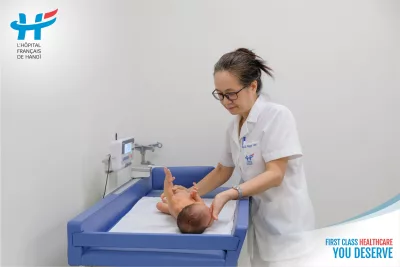Dr. Ho Van Thu, Head of Obstetrics and Gynecology Department at HFH, who directly monitored the pregnancy and performed the emergency cesarean section, shared:
“Ultrasound at 22 weeks of gestation revealed central placenta previa with placenta accreta on a previous cesarean scar. Recognizing the high risk of severe obstetric complications, we implemented a close monitoring plan and provided early interventions. The patient was:
• Administered corticosteroids to promote fetal lung maturity in case an early cesarean delivery was required.
• Followed up regularly under a strict antenatal surveillance plan to promptly detect any abnormalities and determine the optimal timing for delivery.”
This is a rare but extremely dangerous condition.
Central placenta previa occurs when the placenta completely covers the internal cervical os, leading to a high risk of sudden, severe, and recurrent vaginal bleeding during pregnancy.
Meanwhile, placenta accreta spectrum is a condition where the placental villi abnormally attach too deeply into the uterine wall, invading the myometrium instead of the endometrium. The most severe complication is massive postpartum hemorrhage, as the placenta fails to separate naturally after delivery, which can rapidly cause hypovolemic shock and even maternal death if not managed promptly. In many cases, hysterectomy is required to control bleeding and save the patient’s life.
When central placenta previa and placenta accreta coexist, it creates a “double high-risk situation”:
- Early, uncontrollable bleeding may occur as the cervix dilates.
- Severe intraoperative hemorrhage may be difficult to control due to deep placental invasion.
Such cases are therefore classified as high-risk obstetric emergencies, requiring extensive preoperative preparation, adequate blood reserve, and multidisciplinary collaboration.
At 34 weeks and 2 days, the patient presented with vaginal bleeding and was admitted to HFH in a state requiring urgent intervention. After multidisciplinary consultation, Dr. Thu immediately decided to perform an emergency cesarean section to ensure the safety of both mother and baby.
Given the complexity of the case, meticulous preparation was made in advance, including:
- Blood Bank: Large volumes of blood and blood products were mobilized for immediate transfusion if needed.
- Surgical and Anesthesia Team: Fully staffed and well-coordinated to manage potential massive hemorrhage and hemodynamic instability.
- Interventional Radiology Team: On standby to perform vascular embolization if necessary to control bleeding and prevent hypovolemic shock.
During surgery, the patient underwent a subtotal hysterectomy, with careful hemostasis and intensive transfusion support. Thanks to the comprehensive preparation and close coordination between teams, the operation was successful, and both mother and baby were safe.
Postoperatively, the patient received intensive monitoring and postoperative care. Both mother and newborn have since recovered well and were discharged in stable condition.



This case demonstrates:
- The importance of regular antenatal check-ups to detect and manage life-threatening pregnancy complications early.
- The value of close monitoring and planning for high-risk pregnancies.
- The effectiveness of a comprehensive, multidisciplinary approach – involving obstetricians, anesthesiologists, the blood bank, and interventional radiologists – in a hospital equipped with modern facilities and experienced specialists.
Dr. Ho Van Thu emphasized:
“Pregnant women with high-risk conditions should be followed and managed at specialized obstetric centers with full multidisciplinary resources and advanced medical facilities to ensure the safest outcomes for both mother and baby.”





